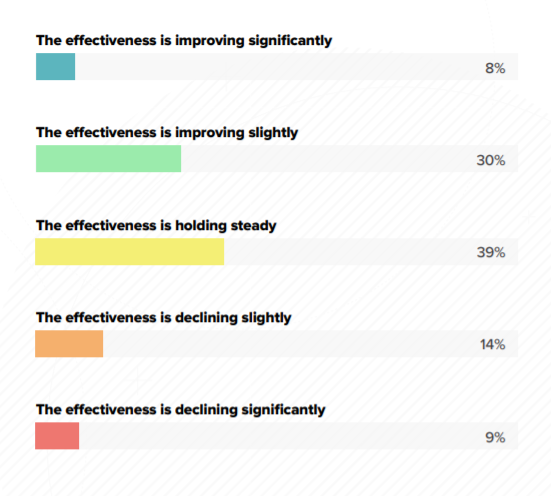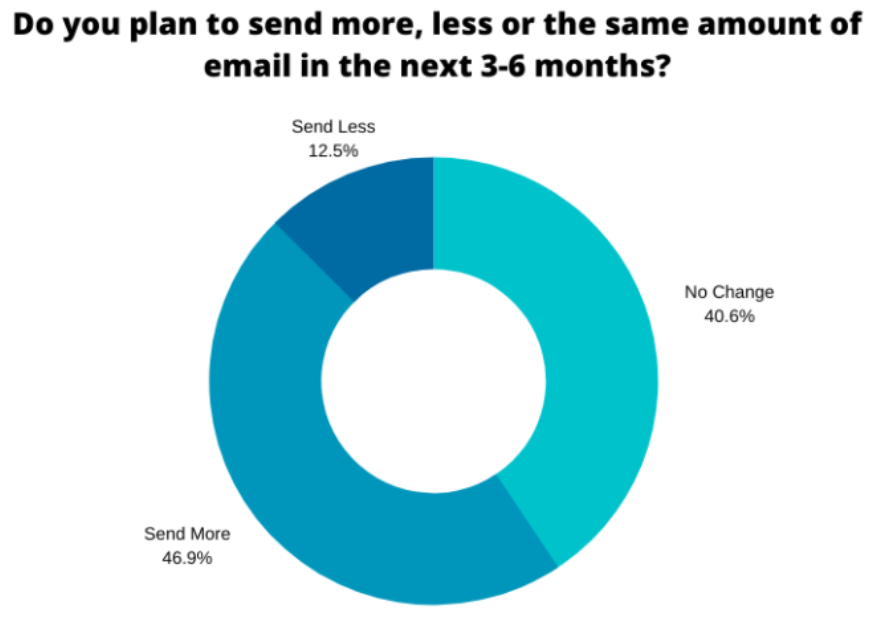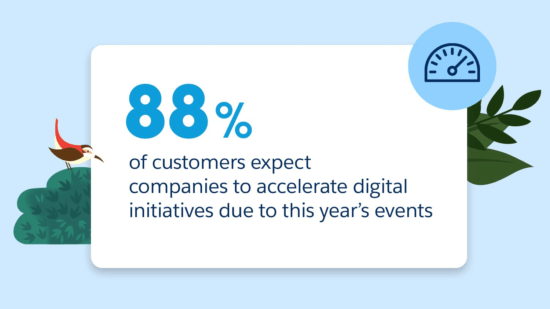"Emails?! Isn't that a bit old hat?" I hear you ask. "Why don't I just send a fax? Or a letter? Or some smoke signals?"
Well, don't dismiss the humble email so easily. It's been a firm friend of the marketer for years, and continues to be, and probably will be a mainstay for many years to come. "I'm sure people said that about cave paintings", you say. Shut up, I say.

Recently, marketers have been putting a bunch of emphasis on webinars, social media, video marketing, or anything shiny they come across.
But anything new and exciting shouldn't distract you completely from the fundamental and effective methods of marketing.
Email generates $42 for every $1 spent which is an astounding 4,2000% ROI. So it may be old, but it's not old hat. Plus, more than three-quarters of marketers report the effective of their emails is improving, or at least holding steady.
How Has the Effectiveness of Email Marketing Changed?
The effectiveness of email marketing might not be changing, but the objectives of email marketing are. The overall percentage of marketers who report "building brand awareness" as a key objective has increased this year. B2C marketers report that "revenue generation" has fallen as a priority, by 35%.
That's not all that has changed. Email marketers are losing sights of the fundamentals. The adoption of email basics has fallen this year, with list hygiene, deliverability optimisation, and A/B testing being neglected.
But still, email marketing is alive and kicking. In fact, according to Litmus, 2020 and onwards are the years of email. But don't people hate getting emails? I hear you ask. No, people hate getting spam emails. If you keep your emails helpful, personalised, informative, and relevant, then you can build trust with your contacts. And this will lead to engagement. Which will lead to sales!
Email marketing has been, and will remain, super affordable. In terms of how it can reach customers, it costs mere pennies to get your message out there. As many small businesses are working on a pretty strict budget, email gives them the chance to keep up with bigger, and better funded, competitors. Email marketing involves very little upfront cost, and is relatively inexpensive to maintain over times. So don't anticipate any hidden costs.
Basically, emails are the tool that can provide the ability to create a fluid, undisrupted, and seamless buyer's journey. It can build relationships with not only customers, but leads, and even past customers. You can address them directly, with a level of personalisation, at their own pace.
Although, this isn't all without hiccups. Because email marketing is so effective, the volume of messages sent is constantly increasing. Statista data suggests that it will continue rising in the years ahead, so competition for attention will become way more intense.
So, instead of focusing on how well email has done in the past, we need to look to the future. Right then, a few 2021-email tips for you then. Starting with:
1.Email Marketing...and Customer Experience
Customer experience is pretty widely recognised as an integral part of digital marketing. Hubspot defines it like so:
“Customer experience is the impression your customers have of your brand as a whole throughout all aspects of the buyer's journey. It results in their view of your brand and impacts factors related to your bottom line including revenue.”
So, you'll want to be providing your customers with the experience they would expect face to face, alongside a seamless user journey. Email users expect a smooth ride right from the outset.
With the pandemic, the need for considered communications and rich digital experiences has skyrocketed. So, email based CX needs to keep up to speed.
“Indeed, recent data show that we have vaulted five years forward in consumer and business digital adoption in a matter of around eight weeks," reported McKinsey. And even with (hopefully) the end of COVID-19, this isn't going backwards.
“I first began teaching on CX marketing in email marketing over 10 years ago – this is what Holistic Email Marketing is based on," says Holistic Email Marketing's CEO Kath Pay.
It was a little known concept back then, but has begun to play a more important role within CRM and email marketing in the past couple of years. CX marketing is a very broad topic and trend, and very simply put can be defined as putting your customer first throughout their customer journey with you. Think about it – email, being a push channel, is often the beginning of a customer’s journey with you."
2. Email Marketing…and AI
According to a survey from Iterable, 83% of respondents said they were likely to use AI in their marketing programmes. And email marketing is no different.
There's more data available online than any one marketer could process, let alone gain insights from. But AI is here to help. Artificial Intelligence is capable of dealing with this task, with minimal effort and time.
This might range from list segmentation to content analysis, to effective outreach. Plus, AI is only improving; soon it'll be able to complete most mundane, time-consuming tasks. So, keep an eye on what AI can do in order to streamline your emails. You might even consider using it to create highly effective subject lines!
3. Email Marketing...and Hyper-personalisation
Even with something as simple as a birthday email can have some pretty impactful effects. According to Experian, wishing your customer many happy returns can pay dividends.
In fact, they say that a birthday email is capable of generating roughly 342% more revenue than a regular promotional email. So, customer appreciation emails play a vital role in a company's successful marketing campaign.
Hyper personalisation can go hand-in-hand with the implementation of AI, which makes it easier to assure personalisation by obtaining more data about your customers. They are often aware of the amount of data collected about them, and expect it to be used to accommodate their needs. It's all about the give and take.
According to research conducted by Janrain and Blue, almost all consumers (96%) have received mistargeted information or promotions. And this can be jarring, if not off-putting.
Valerie Kakovkina, of Nethunt, reports that upon receiving a non-personalised or misdirected email, 94% of customers report taking at least one of the following actions:
- 68%: Automatically delete emails.
- 54%: Unsubscribe from emails.
- 45%: Categorize emails as ‘junk’ or ‘spam’.
- 29%: Become less willing to buy products.
- 13%: Visit the website less frequently.
- 10%: Never visit the website again.
Lack of email marketing campaign personalisation can result from a number of things, including mailing list degradation, to an overall failure of the email marketing campaign because of costs. But remember statistics like these when neglecting your personalisation:
- Personalised messages have an ROI of 122%.
- Personalised subject lines can generate approximately 50% higher open rates than standard subject lines.
4. Email Marketing…and User-generated Content (UGC)
Another trend which has appeared recently is User-generated Content, or UGC.
UGC is basically any content that is created by users of a brand; comments, reviews, images, social media posts, hashtags etc. etc. With 90% of consumers saying user-generated content influences their decisions, more than promo emails and search engine results, USG is impossible to ignore.

There's a good deal of evidence to suggest that UGC promotes conversion. 82% of customers claim that user-generated reviews are extremely valuable. Roughly 70% of all consumers base their purchasing decision on the reviews and ratings from other users.
So, when marketers include this content in their emails, they improve trust towards the product and services. People trust people, over brands.
Plus, you can use USG as content in itself. It's a thrifty way of making sure you meet those email content quotas.
5. Email Marketing…and Interactivity
Interactive emails seems to have found its place in 2023.
This form of email marketing boosts customer engagement, and significantly increases email interaction. A vital lifeline for brands unable to interact face-to-face with customers during the pandemic.
These interactive elements can include such things as:
- Animated buttons and CTAs;
- Rollover effects to showcase product offerings;
- Interactive image and product carousels, controlled by the user;
- Accordion features designed to make long-form emails more compact;
- Surveys, polls and user-generated interactive content.
This all works under the concept of 'gamification'. This means using strategic game designs and mechanics to encourage users to engage with your brand, and motivate them to interact. Gamified solutions offer an advantage by standing out in your subscriber's inbox.

6. Email Marketing…and Redesign
I know, I know it's more about what's inside. But when an email has some really fantastic visuals? Well, then that good lookin' email going to catch the eye of customers, even when they're with their wives.
Good visuals can make a brand a brand, and can be fit exactly to the tone and look of your company.

But it's not just about what kind of visuals are popular at one time. Redesign can also come in the form of optimising for your customer's device. 81% of people across each demographic check their emails using a mobile device. To remain relevant, email marketers need to adjust their emails to fit the screen of smartphones.
According to Valerie Kakovkina, the most popular, upcoming visual trends will include:
- Minimalism. It's been precidiced that all the Nordic minimalism you've been seeing on your Instagram for you page will drift over into your emails. Uncluttered, well-spaced emails with a single message or objective will be popular. People may have become overwhelmed with the amount of digital info beamed into their eyeballs as of late, so will appreciate the clear, concise messaging.
- Dark-mode. Eye-strain is a real thing. Ever since Apple introduced the dark mode, people have been enjoying the dimmed screen, offering a nice break for our over-worked eyes.
- Bright and Bold colours. Okay, this is the direct opposite of the trend above. But with the over-filled inboxes of 2023, it's important to stand out. While you don't want to overload the email with a bunch of images and headings, well-placed eye-catching visuals will engage and entertain your recipients.




